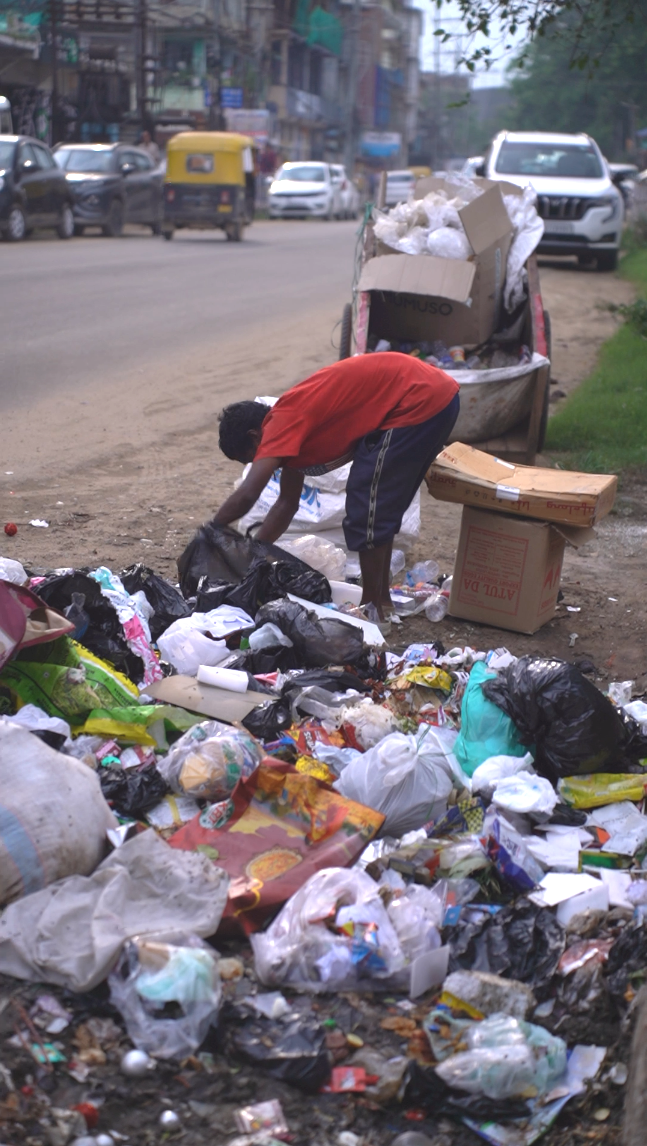Rag pickers play a vital but overlooked role in Nagaland’s waste management, despite unsafe conditions and poor recognition.
Published on Jun 20, 2025
Share

DIMAPUR — In a state struggling with waste management and dumpsite issues, there lies a segment of society—often overlooked and marginalised—the rag pickers.
This group, often living on the sidelines, plays a crucial yet demanding role in waste management and recycling. However, their contributions remain overshadowed because of the nature of the work they do.
In commercial hubs like Dimapur, the state capital Kohima, and the rapidly growing district of Chümoukedima, rag pickers are a common sight. But their presence rarely evokes concern among the public.
Rag pickers, primarily from low-income backgrounds, rummage through garbage dumps, landfills, and streets in search of recyclable materials. They collect discarded items such as plastic, paper, carton, metal, and sometimes glass, which they sell to scrap dealers in exchange for a meagre sum of money.
Also read: Chümoukedima DC issues restrictions on activities along NH-29
They are usually found around residential and commercial areas, outside offices and educational institutions, and predominantly at railway stations, bus stations, and dumping sites. The nature of their work and their socio-economic conditions expose them to numerous hardships. They work in unhygienic conditions while being exposed to harmful materials, toxins, and diseases.
These conditions are largely ignored, as is the reality that rag pickers are performing a vital civic service—unpaid but critical to waste management.
Poverty is constant for rag pickers. With uncertain income and a heavy reliance on the availability and market demand for recyclable materials, their earnings are barely enough to sustain themselves and their families.
A group of young boys rummaging through household and shop waste dumped along Midland Road—which also has educational institutions and healthcare centres—told this newspaper that the undesignated dumping site is where they sift through garbage for recyclable items.
In the middle of their search, the boys—barely in their teens—said that the lack of a stable income has pushed them to do this work. Unbothered about the unhygienic environment and oblivious to the critical waste management work they do, their only purpose is to find as many recyclable items as possible.
According to them, metals, tin, and soft plastic fetch a decent amount, while finding cartons in good condition is considered lucky, as they bring the best rate. The rag pickers said they come to the same spot about two to three times a day since the garbage keeps accumulating. The same pattern is followed by rag pickers at various other locations.
What came to light during the conversation was their complete exposure to biomedical waste. The rag pickers pointed out that at every dumping site, they find soiled sanitary napkins wrapped in newspaper or polythene, human excreta, animal carcasses, broken glass, and other medical waste—mostly from households. This calls for greater awareness of biomedical waste management at the household level.
Why rag pickers are critical for waste management
Rag pickers sustain themselves by collecting, sorting, and segregating waste before selling it to scrap dealers. As a result, they help clean up a significant proportion of the tonnes of waste generated daily.
With rag picking being a completely informal sector, it is difficult to quantify how much waste is collected in this manner.
Yanathung Kithan, Scientist ‘B’ at the Nagaland Pollution Control Board, said, “We don’t have any data on how much they are scavenging, but they are a part of the linkage with the bigger scrap dealers in our town.”
He acknowledged that rag pickers play a big role in waste management and added that their role is recognised in the Solid Waste Management Rules as well.
Living for Environment (LiFE) founder-chairman Niksungla, while acknowledging the silent workforce of rag pickers, admitted that waste management exists because of them. Although she couldn’t estimate the exact percentage of waste they collect or segregate, she said rag pickers handle a large amount of waste from residential and commercial areas as well as dumpsites.
According to her, they are found mostly in Dimapur, Chümoukedima, and Kohima, and many come from neighbouring states. Even before sanitation workers arrive, it is often the rag pickers who segregate the waste.
“A lot of garbage clearing is done informally by rag pickers who work without any job security, salary, or dignity. Not just that, they are regularly exposed to unhygienic environments with the risk of infection. So by the nature of the work they do, they contribute towards waste management,” she said.
She also pointed out that this group is not formally recognised because of the nature of the work. While there may be discussions on recognising the sector, the hesitation lies in the fact that formal recognition would entitle them to various schemes, she opined. They are an invisible workforce, she said, adding that it is time this sector is included and acknowledged.
“Although their nature of work is considered informal, it is crucial to acknowledge that they contribute the most to recycling and segregating the waste—which we fail to do even at the source. Waste is an issue that we do not care about,” she added.